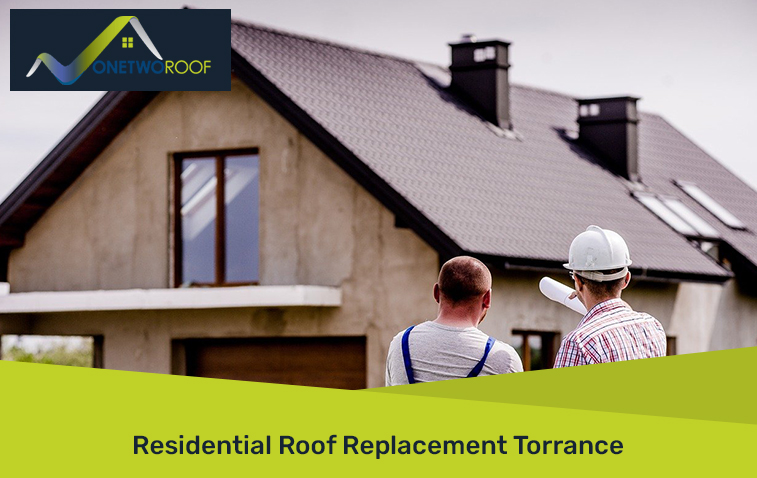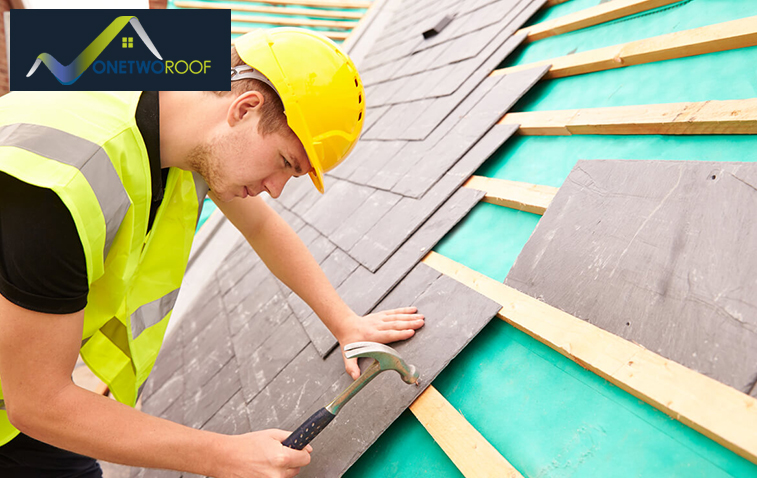Residential Roof Replacement Torrance
Residential roof replacement in Torrance becomes necessary when roofs show signs of extensive damage, such as leaks, missing shingles, or significant wear and tear. Timely replacement is crucial to prevent further water damage, structural issues, and potential hazards.

Hiring a professional contractor for replacing the roof is essential to ensure the successful completion of the project. At One Two Roof, we possess the necessary expertise, experience, and tools to execute the project efficiently and safely. You get a wide range of various services, including thorough roof inspections, material selection guidance, removal of the old roof, installation of new roofing materials, and final clean-up. Contact our team to ensure a reliable and long-lasting solution to protect your home from the elements.
The Components We Help You Replace
When it comes to residential roof replacement in Torrance, it is important to determine the specific parts of your home’s roof that need replacement. The right time for replacement would depend on several factors, including the type of roofing material, the age of the roof, local climate conditions, and any signs of damage or wear. Here are some common roof components that may require replacement
Shingles
Asphalt shingles are the most common roofing material. They generally have a lifespan of 20-30 years. Signs of damage or aging, such as curling, cracking, missing granules, or bald spots, may indicate the need for replacement.
Underlayment
The underlayment is a water-resistant layer installed beneath the shingles. It acts as an additional barrier against leaks. If you notice leaks or the underlayment appears damaged or deteriorated, it might be time for a replacement.
Flashing
Flashing is used around chimneys, vents, and other roof penetrations to prevent water seepage. Damaged or corroded flashing can cause leaks, so it’s important to replace it if it’s deteriorated.
Gutters
While not part of the roof itself, gutters play a crucial role in directing water away from your home. If your gutters are sagging, leaking, or showing signs of rust, you should replace them.
Soffits and Fascia
Soffits are located under the roof’s overhang, while fascia is the vertical board that caps the roof’s edge. These components can deteriorate due to moisture or pests. If you notice rotting, peeling paint, or visible damage, they should be replaced.
Ventilation
Adequate roof ventilation helps regulate temperature and moisture levels in your attic. Insufficient ventilation can lead to issues like excessive heat buildup, mold growth, and premature aging of the roof. Consider replacing or upgrading ventilation components as needed.
Here’s a table outlining the estimated time and cost required to replace various components of a roof:
| Component | Time (hours) | Cost ($) |
|---|---|---|
| Shingles | 8-16 | $1,500-$3,500 |
| Underlayment | 4-8 | $500-$1,500 |
| Flashing | 2-4 | $200-$600 |
| Gutters | 4-8 | $500-$1,500 |
| Soffits and Fascia | 4-8 | $800-$2,000 |
| Ventilation | 2-4 | $400-$800 |
Please note that the actual time and cost may vary depending on various factors such as the size of the roof, the complexity of the project, the location, and the specific materials used.
Residential Roof Replacement in Torrance – The Process
Complete residential roof replacement in Torrance involves several steps to ensure a successful and long-lasting installation. Here are the general steps followed for a complete roof replacement:

Inspection
A professional roofer will assess the condition of your existing roof to determine if it needs to be replaced. They will check for signs of damage, leaks, rot, or any underlying issues.
Material Selection
Once the decision for roof replacement is made, you’ll need to choose the appropriate roofing materials based on your budget, climate, and aesthetic preferences. Common roofing materials include asphalt shingles, metal, tile, slate, or wood shakes.
Obtain Permits
You will need to obtain permits before starting the roof replacement. Your roofing contractor can assist you with the necessary paperwork.
Prepare the Site
Before the installation begins, the area around your house needs to be cleared and prepared. This involves moving outdoor furniture, protecting plants and landscaping, and covering or removing any fragile items.
Tear-off
The existing roof materials are removed, including shingles, underlayment, flashing, and any damaged or rotted sections. This step ensures a clean surface for the new roof installation.
Repair and Preparation
The roof deck is thoroughly inspected for any damage, rot, or structural issues. Repairs are made, and the deck is prepared for the installation of the new roofing materials. This may include replacing damaged plywood or reinforcing the structure if needed.
Installation
The installation process varies depending on the roofing materials chosen. For most roofs, a waterproof underlayment is installed first to provide an additional layer of protection. Then, the roofing material is applied according to the manufacturer’s guidelines. This may involve nailing down shingles, laying tiles, or securing metal panels.
Flashing and Ventilation
Flashing is installed around roof penetrations such as chimneys, vents, and skylights to prevent water infiltration. Proper ventilation is also essential for maintaining the integrity of the roof and preventing issues like moisture buildup and ice dams.
Cleanup
Once the new roof is installed, the area is thoroughly cleaned up, and any debris or leftover materials are removed from the site. Roofing professionals should take care to leave your property in the same condition, or even better, than before the installation.
Final Inspection
A final inspection is conducted to ensure the roof replacement meets the required standards and regulations. This may involve a representative from the local building department or your roofing contractor.
